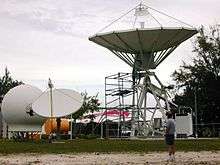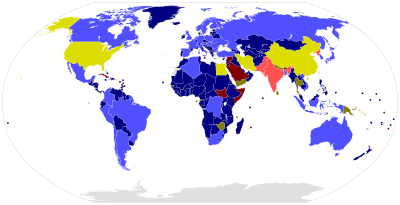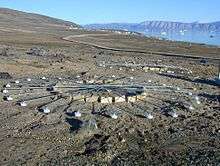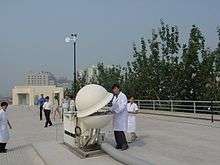Preparatory Commission for the Comprehensive Nuclear-Test-Ban Treaty Organization
|
CTBTO Preparatory Commission logo | |
|
Member States ( ) (States Signatories of the CTBT) | |
| Formation | 19 November 1996[1] |
|---|---|
| Headquarters |
Vienna International Centre, Austria 48°14′05″N 16°25′01″E / 48.23472°N 16.41694°ECoordinates: 48°14′05″N 16°25′01″E / 48.23472°N 16.41694°E |
Membership |
183 member states All states signatories to the CTBT are automatically members. |
Executive Secretary | Lassina Zerbo[2] |
Budget | $45 million plus €60 million (2012)[2] |
Staff | around 250[2] |
| Website | ctbto.org |
The Preparatory Commission for the Comprehensive Nuclear-Test-Ban Treaty Organization, CTBTO Preparatory Commission or CTBTO Prep Com is an international organization based in Vienna, Austria, that is tasked with preparing the activities of the Comprehensive Nuclear-Test-Ban Treaty Organization (CTBTO). The organization was established by the states that signed the Comprehensive Nuclear-Test-Ban Treaty (CTBT) in 1996. Its main purpose is twofold: to promote the entry into force of the CTBT, which bans all nuclear explosions, and to establish a global verification regime to ensure that all nuclear tests are detected.
Organization
The Preparatory Commission has a Plenary Body (sometimes called the Preparatory Commission as well) which meets twice a year and is composed of the countries that signed the CTBT.[3] The commission has two working groups working on financial (Working Group A) and verification matters (Working Group B). Its main activities are performed by the Provisional Technical Secretariat. This organization is led by the Executive Secretary. An overview of Executive Secretaries is shown below:

| Country | Name | Start of Term |
|---|---|---|
| Germany | Wolfgang Hoffmann | 3 March 1997[4] |
| Hungary | Tibor Tóth | 1 August 2005 |
| Burkina Faso | Lassina Zerbo | 1 August 2013 |
Entry into force of the CTBT will result in the dissolution of the CTBTO Preparatory Commission and establishment of the CTBTO at the end of the first Conference of States Parties of the CTBT after entry into force. In that event all assets of the Commission will be transferred to the CTBTO. Entry into force requires ratification by China, Egypt, India, Iran, Israel, North Korea, Pakistan and the United States and takes place 180 days after all these ratifications are received.
Monitoring Systems and Communication systems
The Preparatory Commission has started building the global systems for the detection of nuclear tests. The system consists of an International Monitoring System (IMS), a Global Communications Infrastructure as well as an International Data Center. The systems are not complete but largely operational.
International Monitoring System (IMS)
The International Monitoring System will, when complete, consist of 337 facilities worldwide to monitor the planet for signs of nuclear explosions. Around 85% of the facilities are already up and running.[5] The system will comprise:
- 50 primary and 120 auxiliary seismic monitoring stations. Primary stations deliver data online in real time, whereas auxiliary stations provide data upon request. Seismic data is used to locate seismic events and to distinguish between an underground nuclear explosion and the numerous earthquakes that occur around the globe.
- 11 hydroacoustic stations detecting acoustic waves in the oceans. Six of these are hydrophone stations that use underwater microphones that transmit signals via cable to a shore station. Hydrophone stations are extremely sensitive and pick up acoustic waves from underwater events, including explosions, occurring very far away. The other five are seismic stations located on islands (T-phase stations) that use seismometers to detect acoustic waves converted to seismic waves when they hit the island.
- 60 infrasound stations using microbarographs (acoustic pressure sensors) to detect very low-frequency sound waves in the atmosphere produced by natural and man-made events. These stations are arrays of four to eight sensors which are located one to three kilometers apart. The data are used to locate and to distinguish between atmospheric explosions and natural phenomena such as meteorites, explosive volcanoes and meteorological events as well as man-made phenomena such as re-entering space debris, rocket launches and supersonic aircraft.
- 80 radionuclide stations using air samplers to detect radioactive particles released from atmospheric explosions and/or vented from underground or under-water explosions. The presence of specific radionuclides provides unambiguous evidence of a nuclear explosion. Forty of the stations will be equipped with noble gas detection. There are several activities sponsored by the IMS, one of which is the International Noble Gas Experiment.
- 16 radionuclide laboratories for analysis of samples from the radionuclide stations.
As of January 2013, over 81% of the system had been certified.
| Station type[6] | Planned | Under Construction | Testing | Certified | Total |
|---|---|---|---|---|---|
| Primary Seismic | 3 | 3 | 2 | 42 | 50 |
| Auxiliary Seismic | 4 | 4 | 8 | 104 | 120 |
| Infrasound | 11 | 4 | 0 | 45 | 60 |
| Hydroacoustic | 0 | 1 | 0 | 10 | 11 |
| Radionuclide | 5 | 10 | 3 | 62 | 80 |
Global Communications Infrastructure (GCI) and International Data Centre (IDC)

Data from all stations are transmitted to the CTBTO International Data Centre (IDC) in Vienna through a global private data network known as GCI, which is largely based on satellite (VSAT) links. As of mid-2005, more than half of the planned IMS stations were providing data.
At the IDC, IMS data collected through GCI - approximately 16 gigabytes per day - is stored and correlated using custom software to generate reports of significant events, which are subsequently reviewed by specially trained analysts in order to prepare quality-controlled event bulletins. The IDC operates a large redundant database of events and a 125 terabyte mass storage facility that provides archiving capacity for more than ten years of verification data.
On-Site Inspections (OSI)
Once the CTBT enters into force an on-site inspection [7] can be dispatched to the area of a suspicious nuclear explosion if the data from the IMS indicate that a nuclear test has taken place there. Inspectors will collect evidence on the ground at the suspected site. Such an inspection can only be requested and approved by Member States once the CTBT has entered into force. A large on-site inspection exercise was carried out in September 2008 in Kazakhstan. Another full-scale exercise (known as the Integrated Field Exercise 2014 or IFE14) was carried out in Jordan and Austria from 3 November to 9 December 2014. It was the largest on-site inspection exercise conducted to date and it involved four years of preparation, 150 tons of specialized equipment and over 200 international experts.[8]
2006, 2009 and 2013 Nuclear Tests by North Korea
In the morning of 9 October 2006, North Korea set off a nuclear explosion. It detonated a nuclear device at a test site in the northeast of the country. The CTBTO’s global monitoring network detected the low yield explosion with 22 of its seismic stations. Within two hours of the explosion, CTBTO Member States received initial information about the time, location and magnitude of the blast.
Two weeks after the blast, a monitoring station at Yellowknife in northern Canada detected traces of the radioactive noble gas xenon in the air. The presence of xenon provides evidence that a nuclear explosion has taken place. This detection confirmed that the 2006 North Korean nuclear test was a nuclear explosion. Analysts at the CTBTO then used special calculations to backtrack the detected xenon to determine its source. The calculation indicated that the detected noble gas originated from North Korea.[9]
North Korea conducted a second nuclear test on 25 May 2009. Seismic data indicated an unusually large underground explosion. The blast took place only a few kilometers from where the first nuclear device had been detonated in 2006.
Considerably more seismic stations registered the explosion in 2009 than in 2006. This was due to the greater magnitude of the blast and the higher number of monitoring stations in operation. Two hours after the test, the CTBTO presented initial findings to its Member States. The information available also helped analysts to identify a far smaller area as the location of the explosion. In 2009 the estimated area covered 264 km2 compared to 880 km2 in 2006.[10][11]
In the morning of 12 February 2013 (at 02.57.51 UTC), the CTBTO monitoring system detected another unusual seismic event in North Korea, which measured 4.9 in magnitude. Later that morning, North Korea announced that it had conducted a third nuclear test. The event was registered by 94 seismic stations and two infrasound stations in the CTBTO’s network. The first automatic analysis of location, time and magnitude was made available to Member States in less than an hour.[12] The analysed data showed the event’s location (with a certainty of about +/- 8.1 km) was largely identical with the two previous nuclear tests (Lat.: 41.313 degrees north; long.: 129.101 degrees east). As with the two previous nuclear tests, the signal was emitted from close to the surface.[13]
The CTBTO radionuclide network later made a significant detection of radioactive isotopes of xenon - xenon-131m and xenon-133 - that could be attributed to the nuclear test. The detection was made at the radionuclide station in Takasaki, Japan, located at around 1,000 kilometres, or 620 miles, from the North Korean test site. Lower levels were picked up at another station in Ussuriysk, Russia.[14][15] Using Atmospheric Transport Modelling, which calculates the three-dimensional travel path of airborne radioactivity on the basis of weather data, the North Korean test site was identified as a possible source for the emission.[16][17]
Civil and Scientific Uses of CTBTO Data
The huge amount of data collected by the CTBTO can also be used for purposes other than detecting nuclear explosions, particularly in the field of disaster mitigation and early warning. In 2006, the CTBTO started providing seismic and hydroacoustic data directly to tsunami warning centers. As of 2012, data is shared with tsunami warning centers in eight countries, mainly in the Indo-Pacific region.[18]
Throughout the Fukushima Daiichi nuclear disaster of March 2011, the CTBTO’s radionuclide stations tracked the dispersion of radioactivity on a global scale.[19] More than 1600 detections of radioactive isotopes from the crippled nuclear reactor were picked up by over 40 CTBTO radionuclide monitoring stations. The CTBTO shared its data and analysis with its 183 Member States, as well as international organizations and some 1,200 scientific and academic institutions in 120 countries.[20]
The CTBTO also recorded the infrasound produced in the atmosphere by the meteor explosion over Chelyabinsk, Russia in 2013. Seventeen stations around the world, including one in the Antarctic, recorded the event as the infrasound reverberated around the world multiple times.[21]
Recordings from CTBTO hydrophones was analyzed to determine an impact location for Air France Flight 447 and Malaysia Airlines Flight 370, both of which were lost without a known crash site. No data was detected in the event of Flight 447, even after it was reassessed once the location of the wreckage was known.[22] As of July 2014, Flight 370 remains missing with no known crash site or confirmed debris. Since the only evidence for Flight 370's final resting site comes from an analysis of its satellite transmissions, which has resulted in an imprecise and very large search area, hydroacoustic recordings from CTBTO were analyzed to potentially determine and locate its impact with the Indian Ocean. Analysis of available hydroacoustic recordings (including those made by a CTBTO hydrophone located off Cape Leeuwin, Western Australia) identified one event which may be associated with Flight 370.[22][23][24]
Other potential civil and scientific applications include the use of CTBTO data and technologies in civil aviation and shipping and in climate change research.[25]
References
- ↑ "Comprehensive Nuclear Test-ban Treaty, Meeting of States Signatories" (PDF). CTBTO Preparatory Commission. Retrieved 6 April 2011.
- 1 2 3 "Establishment, Purpose and Activities". CTBTO Preparatory Commission. Retrieved 6 April 2011.
- ↑ "Composition and Structure". CTBTO Preparatory Commission. Retrieved 9 April 2011.
- ↑ "CTBT/PC/I/3/REV.3 Appointment of the Executive Secretary: Terms and Conditions. Decision". CTBTO Preparatory Commission. 3 March 2011. Retrieved 7 April 2011.
- ↑ "Bringing the CTBT into force: looking back at the 2011 Article XIV Conference". Sonya Pillay, VERTIC. Retrieved 15 May 2012.
- ↑ "Station Profiles". CTBTO Preparatory Commission. Retrieved 18 January 2013.
- ↑ "CTBTO On-Site Inspections". CTBTO Preparatory Commission. Retrieved 5 June 2012.
- ↑ "Largest-ever CTBT on-site inspection exercise concludes successfully". CTBTO Preparatory Commission. Retrieved 14 April 2015.
- ↑ "CTBTO Highlight 2007: The CTBT Verification Regime Put to the Test". CTBTO Preparatory Commission.
- ↑ "CTBTO Press Release 2009: CTBTO's Initial Findings on the DPRK's 2009 Announced Nuclear Test". CTBTO Preparatory Commission.
- ↑ "CTBTO Highlight 2009: Experts Sure about Nature of the DPRK Event". CTBTO Preparatory Commission.
- ↑ "CTBTO Press Release 2013: On the CTBTO's detection in North Korea". CTBTO Preparatory Commission.
- ↑ "Update on CTBTO findings related to the announced nuclear test by North Korea". CTBTO Preparatory Commission.
- ↑ "Gases "consistent with" North Korea's February test found: nuclear body". Reuters.
- ↑ "SIPRI Yearbook 2014: Nuclear explosions, 1945–2013". Stockholm International Peace Research Institute (SIPRI).
- ↑ "Video: CTBTO Detects Radioactivity Consistent with North Korean Nuclear Test, announced Feb 2013". CTBTO Preparatory Commission.
- ↑ "Media questions / answers on radionuclide detection". CTBTO Preparatory Commission.
- ↑ "CTBTO Highlight 2010: France Inks Agreement with CTBTO to Receive Tsunami Warnings". CTBTO Preparatory Commission. Retrieved 15 May 2012.
- ↑ "The 11 March Japan Disaster". CTBTO Preparatory Commission. Retrieved 15 May 2012.
- ↑ "CTBTO Press Release 2011: CTBTO to Share Data with IAEA and WHO". CTBTO Preparatory Commission. Retrieved 15 May 2012.
- ↑ Russian Fireball Largest Ever Detected by CTBTO’s Infrasound Sensors, Vienna, 18 February 2013.
- 1 2 Molko, David; Ahlers, Mike; Marsh, Rene (4 June 2014). "Is mystery underwater sound the crash of Flight 370?". CNN. Retrieved 6 July 2014.
- ↑ Wolz, Susanna (4 June 2014). "Curtin researchers in search for acoustic evidence of MH370". Curtin University. Retrieved 6 July 2014.
- ↑ Butler, Declan (11 June 2014). "Sound clue in hunt for MH370". Nature. Retrieved 6 July 2014.
- ↑ "Potential Civil and Scientific Applications of CTBT Verification Data and Technologies". CTBTO Preparatory Commission. Retrieved 15 May 2012.



